

Cup_feeding. Breastfeeding A Jaundiced Baby - Everything You Need To Know. After your baby is born, the maternity staff or your homebirth care providers will keep an eye on your baby’s wellbeing.
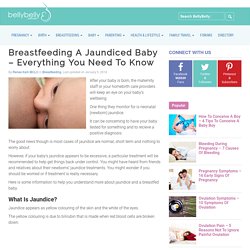
One thing they monitor for is neonatal (newborn) jaundice. It can be concerning to have your baby tested for something and to recieve a positive diagnosis. The good news though is most cases of jaundice are normal, short term and nothing to worry about. However, if your baby’s jaundice appears to be excessive, a particular treatment will be recommended to help get things back under control. You might have heard from friends and relatives about their newborns’ jaundice treatments. Here is some information to help you understand more about jaundice and a breastfed baby. Jaundice appears as yellow colouring of the skin and the white of the eyes. The yellow colouring is due to bilirubin that is made when red blood cells are broken down. Types of Jaundice Normal Physiological Jaundice Newborns get ‘physiological’ jaundice.
Breastfeeding Breast Compression with Dr. Jack Newman. Breastfeeding Using a Lactation Aid with Dr. Jack Newman. Homemade Supplemental Nursing System. Why make your own Supplemental Nursing system (SNS)?
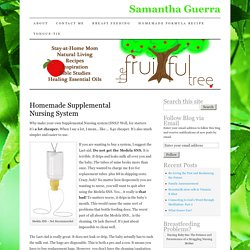
Well, for starters it’s a lot cheaper. When I say a lot, I mean… like…. $40 cheaper. It’s also much simpler and easier to use. Medela SNS – Not Recommended If you are wanting to buy a system, I suggest the Lact-aid. The Lact-Aid is really great. The Lact-Aid. But if you’re only needed to temporarily suppliment your baby and don’t want to spend an arm and a leg to do so, the Home-made SNS is the route to go. Homemade SNS Supplies needed: 10 or 20 ml syringe (10cc or 20cc Luer lock Oring Syringe)infant feeding tube 15 inches long and 5 fr There are several places you can get an infant feeding tube. Is My Baby Hungry? Do I Have Enough Milk?
Effective breastfeeding - it's not all about the latch. It was a new mum that first mentioned this to me, and as soon as she did it dawned on me that she was totally right.

When supporting mums, lots of focus is on latch - because obviously the better the latch, often the less pain and the more effectively baby can feed; but all too often we meet a mum with a slow gaining baby who is always wanting to feed, or perhaps a mum with sore/cracked nipples sometimes resulting in a the shape of a lipstick! And then we hear "the midwife/health visitor has checked my latch and said it was fine... ". Mammæ: My baby is always hungry - maybe I don't have enough milk? This is the last blog in our series about why mums in Northern Ireland give up breastfeeding within the first week of birth.
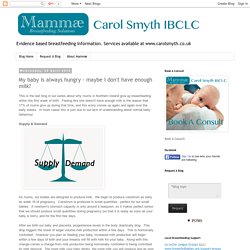
Feeling like she doesn't have enough milk is the reason that 17% of mums give up during that time, and this worry comes up again and again over the early weeks. In most cases this is just due to our lack of understanding about normal baby behaviour. Supply & Demand As mums, our bodies are designed to produce milk. We begin to produce colostrum as early as week 16 of pregnancy. After we birth our baby and placenta, progesterone levels in the body drastically drop. How Culture undermines us The modern world is a difficult place for babies. Then comes the specificity of human milk.
Cache mammals e.g. Here lies the problem. How does milk production work? By Kelly Bonyata, BS, IBCLC To understand how to effectively increase (or decrease) milk supply, we need to look at how milk production works… For the most part, milk production is a “use it or lose it” process.
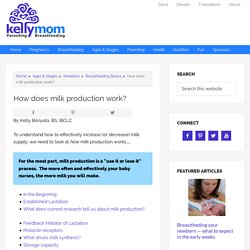
The more often and effectively your baby nurses, the more milk you will make. In the Beginning… Endocrine (Hormonal) Control of Milk Synthesis — Lactogenesis I & II Milk production doesn’t start out as a supply and demand process. During the latter part of pregnancy, the breasts are making colostrum, but high levels of progesterone inhibit milk secretion and keep the volume “turned down”. Analytical Armadillo: Is my breastfed baby getting enough? (and things you ca... I sometimes feel that advice for breastfeeding mums swings like a giant pendulum, rarely stopping in the middle.
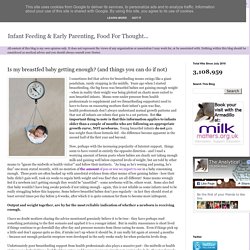
Years ago when I started breastfeeding, the big focus was breastfed babies not gaining enough weight - when in reality their weight was being plotted on charts more suited to non breastfed infants. Mums were under pressure from health professionals to supplement and we (breastfeeding supporters) used to have to focus on reassuring mothers their infant's gain was fine, health professionals don't always understand normal growth patterns and that not all infants are robots that gain to a set pattern. But the important thing to note is that this information applies to infants older than a couple of months who are following an appropriate growth curve, NOT newborns.
Young breastfed infants do not gain less weight than those formula fed - the difference become apparent in the second half of the first year and beyond. The Dangerous Game of the Feeding Interval Obsession - Emma Pickett breastfeeding support. Low Milk Supply 101 - Emma Pickett breastfeeding support. Breast Compression. The purpose of breast compression is to continue the flow of milk to the baby when the baby is only sucking without drinking.
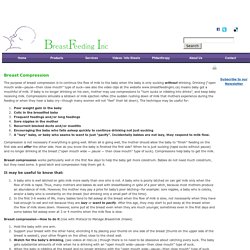
Drinking (“open mouth wide—pause—then close mouth” type of suck—see also the video clips at the website www.breastfeedinginc.ca) means baby got a mouthful of milk.